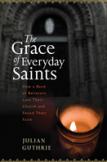A Fight for St. Brigid
Catholic bishops have struggled with the impact of declining church attendance, shrinking numbers of priests and the financial costs of settling priest sexual abuse cases. One solution is to close some churches.
The Grace of Everyday Saints is the riveting story of one such church, St. Brigid, in San Francisco. When Archbishop John Quinn shuttered the church in 1994, shocked parishioners banded together to fight the decision—marking the start of a long-running saga that continues to this day.
The author, Julian Guthrie, is a San Francisco Chronicle journalist who first wrote about the parishioners’ struggle in a series of newspaper articles, which she has now expanded into this compelling book. Guthrie’s narrative brims with drama, tension, surprise and loss. Her descriptions of the faith and lives of the people involved bring the story to life.
Robert Bryan, a nationally known lawyer who represents death row convicts, felt drawn to the parishioners’ cause and became the fiery leader of the Committee to Save St. Brigid. He converted to Catholicism, but eventually became disillusioned with church politics and what he viewed as the arbitrary decision to close the century-old church.
Other activists included Lily Wong, a devoted parishioner from Burma, one of 11 siblings who converted from Buddhism to Catholicism; Joe Dignan, a confused man struggling with his sexual identity before he disclosed to the committee that he was gay; and the Rev. Cyril O’Sullivan, a committed St. Brigid priest who defied the archbishop by actively working with parishioners to save their church. The archbishop soon moved him to another parish to silence him.
To all appearances, Guthrie’s account makes clear, St. Brigid appeared to be a thriving church. There were five Sunday Masses and three daily Masses, celebrated in five languages.
Parishioners met with the archbishop, but he was adamant that the church would not reopen, citing declining Mass attendance and the anticipated high cost of strengthening the church to protect it from earthquakes.
The committee leader Bryan characterized the struggle as one “about good versus evil, about the little guy taking on the powerful.” He even flew to Rome to file an appeal, but no one in the Vatican would meet with him. He accused the archbishop of exercising “morally corrupt leadership.” Tiring of the rancor, the archbishop resigned.
Bryan’s hardball, aggressive leadership eventually split the committee. After a decade at the helm, Bryan gave up his position. Joe Dignan, a younger, less inflammatory leader, succeeded him.
The new archbishop, William Levada, initially seemed more open to compromise, but when the committee offered to raise $1.5 million to upgrade the church, it got no response. Parishioners, however, did succeed in having the church declared a historic landmark so it could not be torn down.
One dramatic subtheme of the story involves the impact of the nationwide sexual abuse scandal involving priests. The San Francisco Archdiocese alone spent $67 million to settle such cases. As Guthrie notes, parishioners believed the archdiocese wanted to sell St. Brigid to raise money to help pay for the settlements, but the archdiocese maintained none of the sale proceeds were used for that purpose.
The St. Brigid story has so many twists and turns that it is hard to summarize them in a short review. At one point the archdiocese agreed to sell St. Brigid to a condominium developer but then backed out of that deal and instead sold the church to the Academy of Art University, which planned to use the building for school and community events.
In 2005 Joe Dignan told the committee, “What I’ve come to learn is that my faith has nothing to do with gold chalices or big cathedrals. It is deep inside.” A year later committee members received the shocking news that Dignan had died suddenly of a heart attack at age 49. The Academy of Art allowed mourners to use the shuttered church for a memorial service.
Despite the loss of their leader and the long odds, the Save St. Brigid committee has vowed to carry on. It continues to meet bi-weekly. One diocesan official has compared the protesters to the Energizer Bunny. They simply never give up. “They believe in something bigger than themselves,” Guthrie writes, “and they are never going to let go—despite the powerful opposition and despite the appearance of getting nowhere.”
Nonfiction books written by reporters often lack depth and a compelling narrative thread, but Guthrie’s account hooks the reader from the start with color, dialogue, telling detail and intrigue, much like good fiction.
Nationwide, the unfortunate economic reality is that some dioceses are close to bankruptcy because of rising costs, declining Mass attendance and multi-million-dollar settlements of sexual abuse cases. Are there options other than closing churches to save money? The author does not say, but perhaps that is a subject for another book.
This article also appeared in print, under the headline “A Fight for St. Brigid,” in the November 7, 2011, issue.







